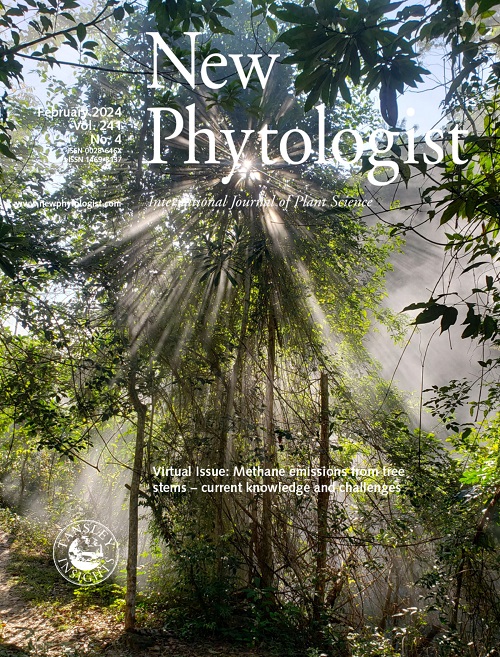在未感染的间质细胞中,由血红素加氧酶介导的血红素分解代谢使日本莲节有效的共生固氮
IF 8.1
1区 生物学
Q1 Agricultural and Biological Sciences
引用次数: 0
摘要
豆科结节产生大量血红素,这是合成豆血红蛋白(Lb)和其他血红蛋白所必需的。尽管Lb在固氮和游离血红素的毒性中起着至关重要的作用,但血红素稳态的机制尚不清楚。采用生化、细胞和遗传等方法研究了血红素加氧酶(HOs)在模式豆科植物荷花血红素降解中的作用。对血红素和胆绿素进行定量和定位,对HOs进行表征,生成LjHO1基因敲除的LORE1和CRISPR/Cas9突变体并进行表型分型。我们发现LjHO1,而不是LjHO2亚型,负责根瘤中的血红素分解代谢,并确定胆绿素是该酶在衰老绿色根瘤中的体内产物。时空表达分析显示LjHO1的表达和胆绿素的产生仅限于未感染的间质细胞的质体。在衰老过程中,ho1突变体的根瘤固氮减少,形成棕色而不是绿色的根瘤。在ho1结节中观察到超氧化物产生增加,强调了LjHO1在抗氧化防御中的重要性。我们得出结论,LjHO1在Lb血红素的降解中起重要作用,揭示了结节质体和未感染的间质细胞在固氮中的新功能。本文章由计算机程序翻译,如有差异,请以英文原文为准。
Heme catabolism mediated by heme oxygenase in uninfected interstitial cells enables efficient symbiotic nitrogen fixation in Lotus japonicus nodules
- Legume nodules produce large quantities of heme required for the synthesis of leghemoglobin (Lb) and other hemoproteins. Despite the crucial function of Lb in nitrogen fixation and the toxicity of free heme, the mechanisms of heme homeostasis remain elusive.
- Biochemical, cellular, and genetic approaches were used to study the role of heme oxygenases (HOs) in heme degradation in the model legume Lotus japonicus. Heme and biliverdin were quantified and localized, HOs were characterized, and knockout LORE1 and CRISPR/Cas9 mutants for LjHO1 were generated and phenotyped.
- We show that LjHO1, but not the LjHO2 isoform, is responsible for heme catabolism in nodules and identify biliverdin as the in vivo product of the enzyme in senescing green nodules. Spatiotemporal expression analysis revealed that LjHO1 expression and biliverdin production are restricted to the plastids of uninfected interstitial cells. The nodules of ho1 mutants showed decreased nitrogen fixation, and the development of brown, rather than green, nodules during senescence. Increased superoxide production was observed in ho1 nodules, underscoring the importance of LjHO1 in antioxidant defense.
- We conclude that LjHO1 plays an essential role in degradation of Lb heme, uncovering a novel function of nodule plastids and uninfected interstitial cells in nitrogen fixation.
求助全文
通过发布文献求助,成功后即可免费获取论文全文。
去求助
来源期刊

New Phytologist
PLANT SCIENCES-
CiteScore
17.60
自引率
5.30%
发文量
728
审稿时长
1 months
期刊介绍:
New Phytologist is a leading publication that showcases exceptional and groundbreaking research in plant science and its practical applications. With a focus on five distinct sections - Physiology & Development, Environment, Interaction, Evolution, and Transformative Plant Biotechnology - the journal covers a wide array of topics ranging from cellular processes to the impact of global environmental changes. We encourage the use of interdisciplinary approaches, and our content is structured to reflect this. Our journal acknowledges the diverse techniques employed in plant science, including molecular and cell biology, functional genomics, modeling, and system-based approaches, across various subfields.
 求助内容:
求助内容: 应助结果提醒方式:
应助结果提醒方式:


